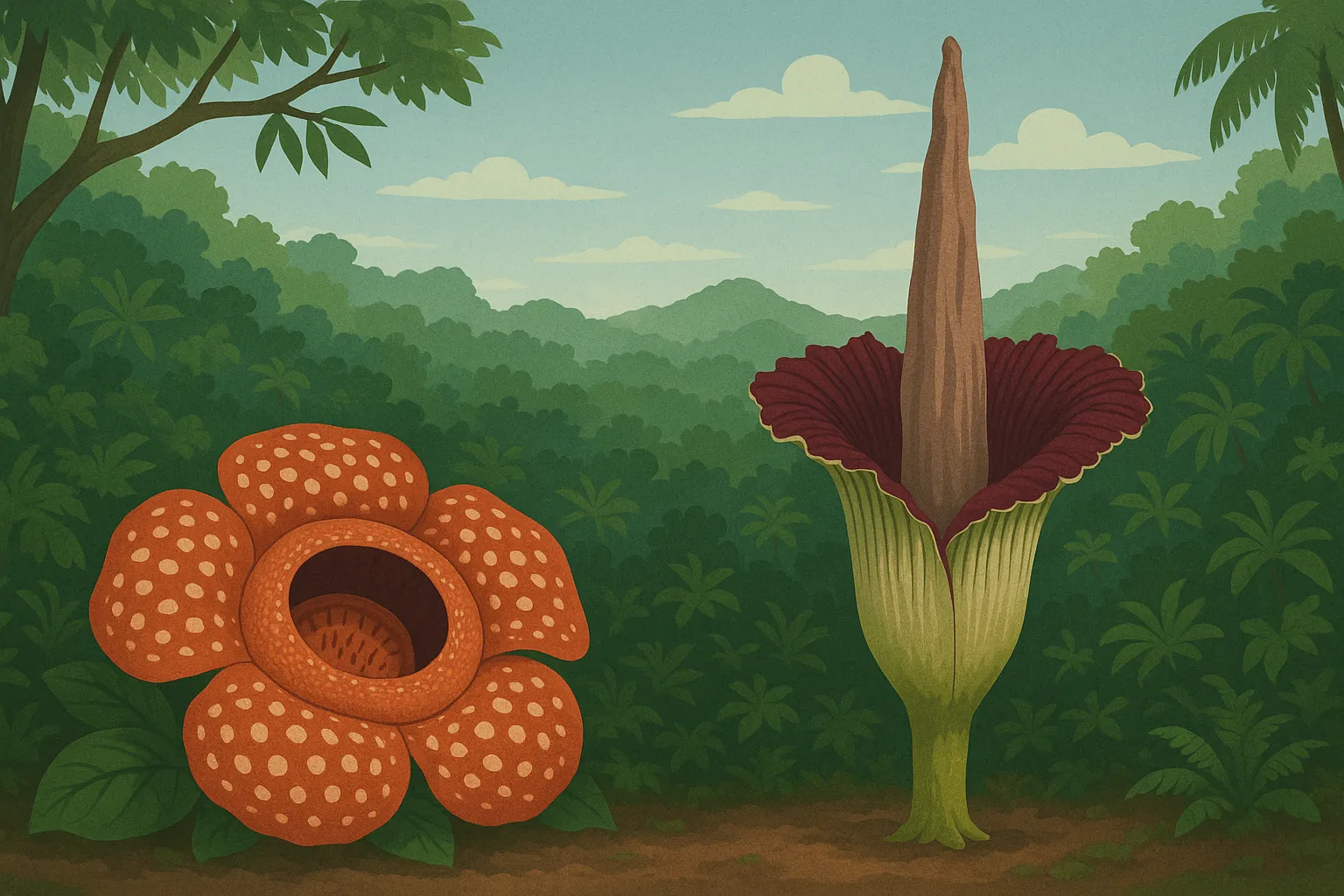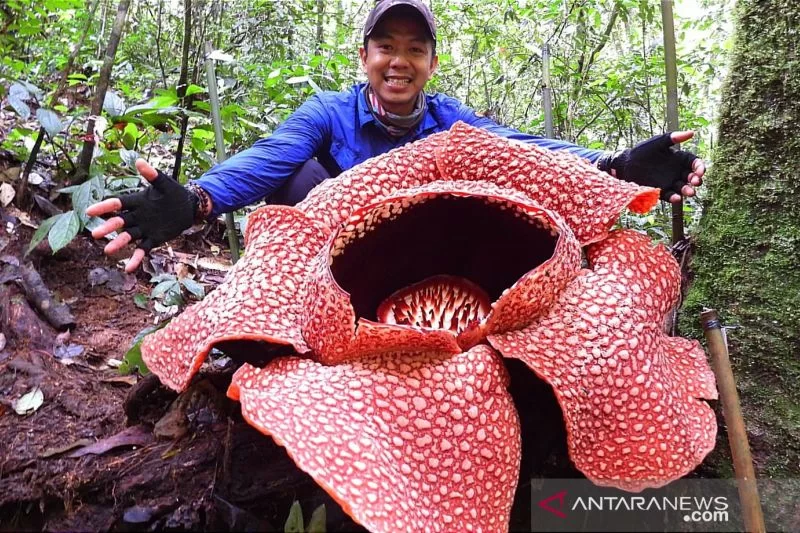Indonesia, with its dense tropical rainforests, is home to countless botanical wonders. Among its extraordinary floral richness, two flower species stand out as the most fascinating and mysterious icons: Rafflesia arnoldii and Amorphophallus titanum. Both are known for their colossal size and distinctive aroma, often dubbed “corpse flowers,” attracting the attention of scientists and tourists from around the world.

Image source:
Illustration generated by AI using OpenAI’s DALL·E.
Although both are giant in size and emit a pungent odor, they belong to different families and possess unique characteristics that set them apart. Let’s delve deeper into the charm and mystery of these two endemic flowers, the pride of Indonesia. For a broader overview of Indonesian rich biodiversity and conservation efforts, you can explore our main pillar article.
See Table of Contents
Rafflesia arnoldii: The Giant Corpse Flower Without Leaves or Stems
Rafflesia arnoldii is one of nature’s most astonishing wonders. Named after its discoverer, Joseph Arnold, and explorer Sir Stamford Raffles, this flower was first found in the forests of Sumatra in 1818. What distinguishes Rafflesia most is that it is an obligate parasitic plant, meaning it relies entirely on its host for survival.

Unique Characteristics of Rafflesia arnoldii:
- True Parasite: Rafflesia has no roots, stems, or leaves of its own. Its entire growth occurs within the tissue of its host plant (usually from the genus Tetrastigma, a type of vine). Only its flower emerges to bloom.
- Colossal Size: A Rafflesia arnoldii flower can reach a diameter of up to 1 meter and weigh over 10 kilograms, making it the largest single flower in the world.
- Distinctive Aroma: This flower emits a putrid smell like rotting meat, which serves to attract pollinating insects such as flies.
- Short Blooming Period: One of the biggest challenges in seeing Rafflesia is its very short blooming period, only about 5-7 days, after which the flower will wither and decay.
- Habitat: Commonly found in primary rainforests on the islands of Sumatra (especially Bengkulu, South Sumatra, and Aceh) and Borneo.
Amorphophallus titanum: The Tall Corpse Flower of the Jungle
While Rafflesia is known for its width, Amorphophallus titanum holds the record as the tallest unbranched flower in the world. Also found in Sumatra, this flower belongs to the Araceae (aroid) family and has an equally fascinating life cycle.
Unique Characteristics of Amorphophallus titanum:
- Unique Structure: What we see as a “flower” is actually a compound inflorescence. It consists of a maroon-colored spathe surrounding a tall central spadix. Its height can exceed 3 meters.
- Life Cycle: Amorphophallus titanum has an interesting life cycle. It grows from a corm underground. After several years, it will produce a single giant leaf that can resemble a small tree. Then, the leaf will wither, and the corm will enter a dormant phase, before finally producing the iconic inflorescence.
- Aroma Intens: Like Rafflesia, this flower also emits a strong foul odor, very effective in attracting pollinating insects such as flies and carrion beetles.
- Rare Bloom: The blooming of this flower is also a rare event, usually occurring only once every few years, and its blooming period is short, only about 2-3 days.
- Habitat: Native to the tropical rainforests of Sumatra, although it is now widely cultivated in botanical gardens worldwide.
Threats, Importance, and General Conservation Efforts
These two giant flowers, with their uniqueness and mystery, are not only captivating but also serve as a reminder of the fragility of our ecosystems. They are important indicators of rainforest ecological health, and their presence indicates that the forest is still relatively intact and capable of supporting complex life. Protecting them means protecting the entire ecosystem they inhabit.
Major Threats to Rafflesia and Amorphophallus:
- Habitat Loss: Primarily due to deforestation, land clearing for plantations, and land use change.
- Short Lifespan: The naturally brief blooming period makes their reproduction and survival very vulnerable.
- Ecosystem Dependence: Rafflesia’s reliance on specific hosts and both flowers’ dependence on primary forests make them highly sensitive to environmental disturbances.
General Conservation Efforts Undertaken:
- Habitat Protection: Maintaining the integrity and sustainability of the forests where they grow.
- Education and Awareness: Increasing public understanding of the importance of protecting these species and their habitats.
- Cultivation in Botanical Gardens: Efforts to cultivate them outside their natural habitat for research and preservation, though challenging for both species.
Case Study: Communication Strategy for Rafflesia Arnoldii Conservation by KPPLB in Bengkulu
Environmental problems such as forest burning, illegal logging, and destruction of host plant seedlings increasingly threaten the growth of Rafflesia Arnoldii flowers in the forest areas of Bengkulu. Therefore, serious efforts are desperately needed to increase public awareness and concern for the environment to prevent the extinction of this flower, which is a symbol of the city of Bengkulu.
An in-depth study on how local organizations are trying to address these challenges has been explained in a thesis titled “Strategi Komunikasi Lingkungan Komunitas Peduli Puspa Langka Bengkulu (KPPLB) Dalam Kampanye Pelestarian Bunga Rafflesia Arnoldii”. This scientific work was written by **Rian Ade Saputra (Student ID: 18321184)**, a student of the Communication Science Program, Faculty of Psychology and Cultural Social Sciences, Universitas Islam Indonesia, in 2022.
KPPLB’s Communication Strategy:
In his research, Saputra outlines that the Bengkulu Rare Flower Care Community (KPPLB) implements a structured communication planning in their campaigns, following four stages of strategic management:
- Assessment: Identifying problems and needs.
- Planning: Designing communication strategies and objectives.
- Production: Creating communication materials.
- Implementation: Executing campaigns and activities.
Communication Approaches and Media Used:
KPPLB not only relies on media but also actively conducts direct activities such as face-to-face socialization and education with the public, emphasizing the importance of the Rafflesia Arnoldii flower. Additionally, they utilize various media platforms to disseminate conservation messages, including social media like Instagram and Facebook, websites, and local television stations such as RBtv and Betv. The study highlights that KPPLB’s educational efforts include understanding environmental impacts, explaining the value of the flower to the ecosystem, providing tips for visitors or tourists, and optimizing word-of-mouth communication as an effective tool for information dissemination.
Further information on KPPLB’s communication strategy and the complete research findings can be accessed through Rian Ade Saputra’s thesis in the Universitas Islam Indonesia’s digital repository:
Read Full Thesis: Strategi Komunikasi Lingkungan Komunitas Peduli Puspa Langka Bengkulu (KPPLB) Dalam Kampanye Pelestarian Bunga Rafflesia Arnoldii
Conclusion: Protecting Indonesia’s Endemic Wonders
Rafflesia arnoldii and Amorphophallus titanum are two invaluable botanical gems of Indonesia. Their story is not just about beauty and uniqueness, but also about the struggle for survival amidst modern threats. Conservation efforts, from the government, organizations like KPPLB, and public participation, are crucial to ensure that future generations can also witness these endemic wonders in their natural habitat. By continuously educating and acting, we can contribute to the preservation of Indonesia’s rare flora. For more information on Indonesia’s broader biodiversity and conservation initiatives, please explore our comprehensive pillar content on the topic.
